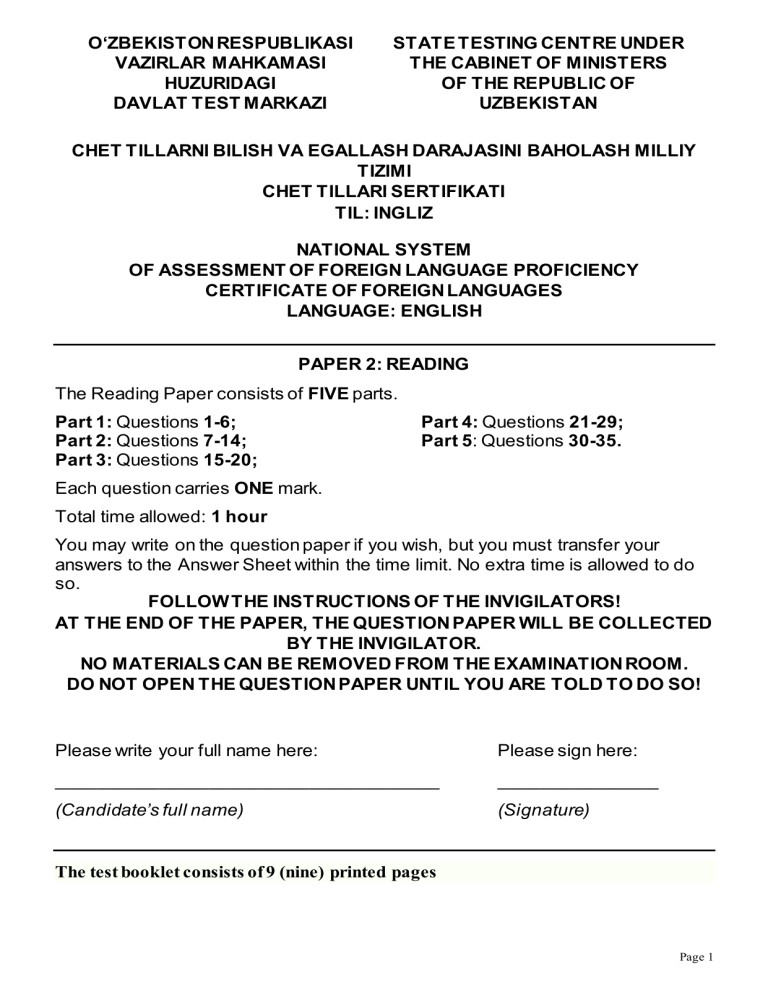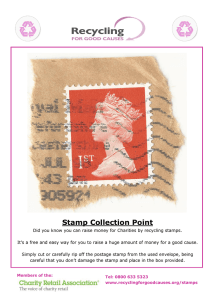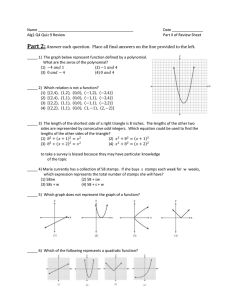
O‘ZBEKISTON RESPUBLIKASI VAZIRLAR MAHKAMASI HUZURIDAGI DAVLAT TEST MARKAZI STATE TESTING CENTRE UNDER THE CABINET OF MINISTERS OF THE REPUBLIC OF UZBEKISTAN CHET TILLARNI BILISH VA EGALLASH DARAJASINI BAHOLASH MILLIY TIZIMI CHET TILLARI SERTIFIKATI TIL: INGLIZ NATIONAL SYSTEM OF ASSESSMENT OF FOREIGN LANGUAGE PROFICIENCY CERTIFICATE OF FOREIGN LANGUAGES LANGUAGE: ENGLISH PAPER 2: READING The Reading Paper consists of FIVE parts. Part 1: Questions 1-6; Part 2: Questions 7-14; Part 3: Questions 15-20; Part 4: Questions 21-29; Part 5: Questions 30-35. Each question carries ONE mark. Total time allowed: 1 hour You may write on the question paper if you wish, but you must transfer your answers to the Answer Sheet within the time limit. No extra time is allowed to do so. FOLLOW THE INSTRUCTIONS OF THE INVIGILATORS! AT THE END OF THE PAPER, THE QUESTION PAPER WILL BE COLLECTED BY THE INVIGILATOR. NO MATERIALS CAN BE REMOVED FROM THE EXAMINATION ROOM. DO NOT OPEN THE QUESTION PAPER UNTIL YOU ARE TOLD TO DO SO! Please write your full name here: Please sign here: ______________________________________ ________________ (Candidate’s full name) (Signature) The test booklet consists of 9 (nine) printed pages Page 1 PART 1 Read the text. Fill in each gap with ONE word. You must use a word which is somewhere in the rest of the text. Looking for a new Earth For thousands of years, humans have explored the Earth. Nowadays, we are exploring space. Astronomers are the modern-day explorers. Currently, many (1) _________________ are looking for new planets and new places for humans to live in the future. But where do astronomers start looking? First of all, astronomers look for a star. That’s because our own Earth orbits a star (the Sun). More importantly, it is the correct distance from the Sun for heat and light. So when astronomers have found the (2) _________________, they look at the planets around it. In recent years, astronomers have found nearly 400 new planets with stars. Unfortunately, many of these (3) _________________ are either too near to the star or too far away. However, if the planet is in a good position, astronomers (4) _________________ for three key things: water, air and rock. Water is important because all life needs water. Humans can drink it and they can also grow plants with water. And (5) _________________ produce air for humans to breathe and food to eat. So all life on other planets will need water and air. (6) _________________ on a planet is also important. That’s because there is often water under the rocks. PART 2 Read the texts 7-14 and the statements A-J. Decide which text matches with the situation described in the statements. Each statement can be used ONCE only. There are TWO extra statements which you do not need to use. Mark your answers on the answer sheet. A) B) C) D) E) F) G) H) I) J) You need to learn the language for your job. You would like to continue your studies in another country. You want to learn the language and do interesting things in your free time. You want to learn the language in London. You want to have a higher education in England. You want to learn the language next summer. You need a free place to stay while studying. You would like to learn more than one language. You need to take an exam, finishing the course. You want to meet people from local companies during the course. Page 2 7 11 8 12 9 13 10 14 Page 3 PART 3 Read the text and choose the correct heading for each paragraph from the list of headings below. There are more headings than paragraphs, so you will not use all of them. You cannot use any heading more than once. Mark your answers on the answer sheet. List of headings: A) All to protect nature B) To change the outlook on nature C) For the lovers of quiet D) Necessary steps to take E) Impact of global warming F) Eco-friendly solutions G) Building of the future H) Combination of nice and ugly 15. 16. 17. 18. 19. 20. Paragraph I Paragraph II Paragraph III Paragraph IV Paragraph V Paragraph VI THE ULTIMATE GREEN HOME Sandwiched between an incredibly ugly shopping centre and a busy main road, the environmentalist Sir David Attenborough, no less, is planting a tree and declaring: ‘Today is a historic day.’ He really means it. I. Maybe our children’s future will be an overheated, desert-like world, but if it’s not, it will probably look a lot like this. The new, highly environmentally friendly home of the World Wide Fund for Nature, a hemispherical glass tube standing above a council car park, was officially opened today, watched by a small but enthusiastic crowd. If humanity is to survive, they must have been thinking, it will do so living in buildings of this kind. II. Known as the ‘Living Planet Centre’, it has jumping panda animations that greet visitors to its WWF Experience, where schoolchildren can interact with Ocean, River, Forest and Wildlife Zones. Since the mid-20th century, many of the ideas behind humanity’s attempts to protect animals and the natural world have been started by the WWF. It is hoped their new home will be a living example of that. Page 4 III. ‘The World Wide Fund for Nature is one of the great hopes for the world,’ Sir David Attenborough said. ‘This building enshrines that, and advertises it to the world.’ The concrete is all recycled, as is the carpet and even most of the computer equipment, and there are many solar energy panels. Other such features include extensive glass to increase natural light, natural ventilation, rainwater in the toilets, and heat pumps that bring warm air up from 200 metres below. In addition, new habitats and plant species have been installed around the gardens, while indoors a home has been found for three tall trees. IV. The sense of total calm inside, from the high curved ceilings to the plants and trees, is all the more remarkable for the building’s urban location. It has been built between a canal and a small area of woods listed as a Site of Special Scientific Interest. Even so, it remains in an ugly corner of a fairly unattractive town centre. The contrast gives us an idea of what might just be possible in the future. V. The WWF was set up in 1961. The organisation originally fought to protect individual species, such as the Arabian oryx, from extinction. Eventually, the focus moved from individual species to ecosystems: all the living things in one area and the way they affect each other. Sir David, who is an ambassador for the WWF, said: ‘Now, it’s not just individual ecosystems. Now the change is to a global approach. If you want to do something, you have to persuade people of the world not to pollute. That is because the planet is one vast ecosystem. The WWF has been the leader in changing everyone’s attitudes towards nature.’ VI. Sir David is clear about the task ahead, and more importantly, unlike many environmentalists, he believes it is not too late to make a difference. ‘You can’t turn the clock back, of course. That means you can’t put back forests that are gone, not for a century, and the population size is not going to shrink. But we can slow down the rate at which the numbers are increasing, we can cut down the carbon we put in the atmosphere,’ he said. ‘It’s never happened before that the whole world has come together and made a decision’. To go as far as we have done to reduce carbon is an impressive achievement. Page 5 Part 4 Read the following text for questions 21-29. STAMPS My parents called me Penelope and, as often happens with first names in the UK, it was shortened to Penny. When I first went to school teachers teased me about my name. They started to call me Penny Black. I had no idea why it was so funny or why they changed my name from White to Black. Later I discovered that this was the name of the very first stamp. I was so absorbed I had to find out more; I started collecting when I was eight. Stamps are one of those everyday items that people, especially children, take for granted. In our world of email and text messaging it’s almost impossible to imagine a time when you couldn’t communicate to anyone in writing at all. Before 1635 there was only one person who could send and receive letters in Britain and that was the monarch – letters were only carried to and from the Royal Court. It was King Charles I who allowed the use of the Royal Mail to members of the public and that’s when the Post Office system was founded. But the whole process of sending a letter was both complicated and expensive. Because the fee was calculated on how many sheets were written and the distance travelled. So, as a result it was only businesses and the wealthy who could afford to send letters. All this changed on 6 May 1840 when the world’s earliest adhesive postage stamp went on sale. Not only was the process of sending a letter made easier but, at only one penny a stamp, it was also affordable for everyone. The impact of the Pe nny Black was incredible. First of all literacy standards improved dramatically. Then economic growth increased as people started to use stamps to invest their hard-earned money. No more saving your pennies in a sock under the bed! So a small piece of gummed paper revolutionised a country. But others were quick to follow. The Brazilians were next issuing their famous ‘Bull’s Eye’ stamps on 1 August 1843, they were followed by Switzerland in the same year, the USA and Mauritius in 1847 and then France and Belgium in 1849. But far from having just an administrative function stamps also reflect the society that produces them. I remember being fascinated by my first stamps from Magyar Posta – first of all I never knew where Magyar was and secondly because the stamps had a heroic, working class feel about them. There were often pictures of young people working in agriculture or industry – scenes which would never appear on a British stamp. In such a small image there was a clear message about the people’s attitude to their work and country, and politics. In the UK, we favour portraying individuals famous for their personal achievements. The person who has appeared on most stamps, other than a British monarch, is Sir Winston Churchill, the prime minister during the Second World War. The second is the Italian-born explorer Christopher Columbus although they tend to picture his ships, or places named after him, rather than an actual portrait of the man. For me one of the most interesting sets of stamps, historically, is the one issued in January 1900 by the Nicaraguans. The US government had long been interested in a canal cutting through Central America but couldn’t decide on whether it should be in Nicaragua or Panama. Then Nicaragua issued a new definitive series of stamps whose main design showed Mount Momotombo with smoke billowing from its highest point. A rival to the idea of Nicaragua being favoured circulated the stamps to every US Congressman and Senator and as a result Panama was chosen. In fact, the volcano had been dormant for centuries but the artist wanted the mountain to look more interesting! Page 6 For questions 21-24, choose the correct answer A, B, C, or D. Mark your answers on the answer sheet. 21. It is stated that Charles I … A) used to be the first postman. B) sent letters to the public only. C) was the founder of the Royal Mail. D) established the postal service. 22. When was the first stamp created? A) 1635 B) 1840 C) 1843 D) 1964 23. The Penny Black had a huge impact on … A) stamp. B) economy. C) letters. D) standards. 24. Unlike the UK, in some countries, stamps… A) reflected individuals’ way of thinking. B) were the symbol of possessions. C) had the portraits of local buildings. D) were produced by high-class people. For questions 25-29, decide if the following statements agree with the information given in the text. Mark your answers on the answer sheet. 25. The author herself changed her name because of stamps. A) True B) False C) No Information 26. The number of pages was estimated to set exact price. A) True B) False C) No Information 27. Stamps made a great contribution to the development of the UK. A) True B) False C) No Information 28. Italian stamps often pictured Christopher Columbus’s ships. A) True B) False C) No Information 29. The US government decided that a canal in Central America should be in Nicaragua. A) True B) False C) No Information Page 7 Part 5 Read the following text for questions 30-35. MIGRATORY LIFESTYLE Out of a world population of 7.5 billion, around 30 million people currently lead a migratory lifestyle. Every continent has nomadic groups, leading a life very different from the sedentary communities they come into contact with. Almost all migratory communities are in steady decline for a wide range of reasons: climate change, political unrest, forced resettlement and armed conflict have all impacted on these traditional communities, diminishing their numbers year on year. However, the lure of the travelling lifestyle is as strong as ever. The 'gypsy lifestyle' continues to inspire people - especially the young - who crave the freedom of unstructured movement. Backpacking has become almost a rite of passage for the young. 'Gap years' between school and university often stretch to two years, or even more, as young people become addicted to the culture of travelling light and moving on. Traditional nomads may be seen as 'wanderers', but their movement is not as unstructured as it may appear. Most nomadic communities are, or were, herdsmen, leading their animals across fixed routes based on pastures. Their societies were based on strong bonds of kinship. According to 14th-century social historian lbn Khaldun, the Bedouin community owed their success in battle to osobiyyo or 'group feeling', which enhanced their ability to protect the group from outsiders. This, along with excellent horsemanship and the rigours of a harsh lifestyle, based around constant alertness needed to protect livestock, made them formidable adversaries in war when compared to their more settled counterparts. Far from the desert-dwelling Bedouin live a different kind of nomad: the Moken, or sea gypsies, of the Mergui Archipelago between Myanmar and the islands of Thailand's North Andaman coast. During the dry season, they live on traditional houseboats, and during the monsoon season they build temporary villages on sheltered stretches of beach. Theirs is a culture of sharing and giving, to the extent that their language contains no words for individual possessions. These indigenous people have a great understanding of and respect for their environment, making use of over 80 plant species for food and more than 100 for shelter, handicrafts and other purposes. However, the Moken's lifestyle has more recently been affected by government restrictions on their hunter-gathering activities, and legal disputes over ownership of their traditional lands. Somewhat inevitably, they have become a focus for tourism in the area, which they have embraced to some extent as they try to adapt to the modern world. Nomadic communities exist in Europe too. In the tundras and taigas of northern Scandinavia live a reindeer-herding community, the Sami. Originally travelling freely across the areas which now belong to Norway, Sweden, Finland and Russia, this subculture has had its traditional lifestyle curtailed by the creation of national borders. Page 8 For questions 30-33, fill in the missing information in the numbered spaces. Write no more than ONE WORD and / or A NUMBER for each question. Migratory lifestyles (30) __________ the youth who are eager to have unplanned travel. Nomadic herders tend to choose their way taking (31) __________ into account. The Bedouin community had to be cautious all the time to (32) __________ their farm animals. The Moken have no words for (33) _________ property. For questions 34-35, choose the correct answer A, B, C, or D. Mark your answers on the answer sheet. 34. According to the passage, the Moken … A) hardly share their own possessions. B) live on the sea during the rainy season. C) changed their lifestyle because of restrictions. D) escaped to become accustomed to the modern world. 35. What is the writer’s purpose in the reading passage? A) to explain the future of backpacking culture B) to compare the success of different nomadic groups C) to criticize the lack of tolerance for travelling communities D) to highlight the current state of traditional travelling cultures Page 9

